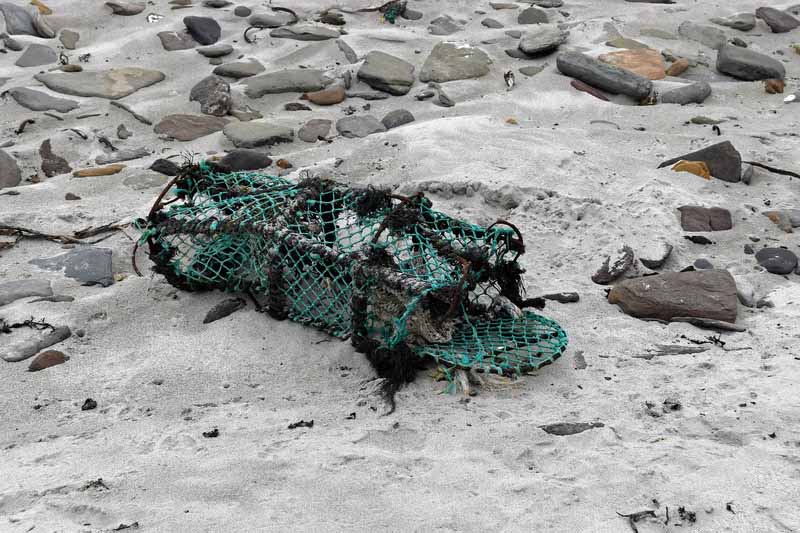Phantom networks. 4 keys to understand the problem and the potential solution
Últimas noticias
Una mirada LGTBIQ+ al reino animal
Circular Economy in Action: Valorisation of By-products through Projects like PRIMA NEWFEED
Strategic Perspectives: Highlights from the Food4Future World Summit for Business Leaders
ELSA CUENDE, expert on fishing technologies at AZTI.
‘Phantom nets’ are fishing nets that are lost or left behind during fishing. How do they affect the ecosystem and species, and what can be done to reduce their occurrence? We tell you.
Índice de contenidos
1. How and why do fishing nets go to sea? How long does it take for them to desintegrate?
Fishing gear may be either voluntarily or unintentionally abandoned, lost or discarded at sea for a wide number of reasons. In particular these can be: bad weather conditions, effect of sea currents and waves, interactions with animals or the seabed, lack of experience in fishing operations, lack of social awareness, interaction between fishing gear and insufficient and/or ineffective management and preventive measures.
Currently, fishing gear is made of resistant, durable and non-biodegradable materials, so when lost, abandoned or discarded, it can remain at sea for decades, causing negative impacts. The degradation time is highly variable depending on the gear’s polymer properties and environmental conditions. When exposed to light and wave effects, including bottom abrasion or contact with other marine structures, these materials can break up into smaller fragments called meso- and microplastics. These, at the same time, have a negative impact on the environment.
How much of a problem are phantom networks today?
Abandoned, lost, or otherwise discarded fishing gears (ALDFGs) are becoming increasingly a problem of concern to the scientific community, policy makers and the fishing industry itself, as they represent a major part of global marine pollution. This pollution also has negative effects on fisheries, the food industry, coastal communities, animal life and natural habitats (Macfadyen et al., 2009; Richardson et al., 2019b). As a reference, up to 40% of waste in some European marine regions is from marine sources, including mainly the fisheries and maritime sector. In fact, recent studies estimate that globally, 5.7% of all fishing nets, 8.6% of pots (fishing traps) and 29% of used lines (e.g. on longlines) are lost in the oceans each year.
2. How do fishing nets affect animals?
Gear that are lost at sea (either voluntarily abandoned or lost) can sometimes continue to fish indefinitely, commonly referred to as phantom fishing or “ghost fishing”. ALDFGs may float or sink, but in either case they may continue to catch fish or other marine organisms. This means that these organisms can become trapped or entangled in the gear, cause injuries when in contact with the phantom nets, and can ingest fragments of their materials.

3. What other effects do phantom nets have on marine ecosystems?
Additionally to the effects on living organisms, lost gear can also damage natural habitats such as the seabed. There, a piece of fishing gear is vulnerable to ocean currents and has a negative impact on the ecosystem due to the effect of friction on the bottom (abrasion). On the other hand, several studies have shown that fishing gear can create habitats for invasive species, which can also have a negative impact on these ecosystems. However, there are also some studies that have shown that they can become a new substrate for new marine life colonisation.
Moreover, in addition to the effects on marine ecosystems, it is important to mention that lost gear can represent a risk to maritime navigation and safety activities, as well as having a negative impact on the economy and tourism of coastal communities.
4. What can be done to reduce phantom networks?
There are 2 main strategies::
- Reduce (avoid reaching the environment) and
- Mitigate (reduce its impact on the environment)
According to an FAO report, prevention measures include the marking of fishing gear, the reduction of fishing effort or the creation/promotion of management bodies for the storage of fishing gear in port at the end of its life. Implementing these measures may reduce the risk of ALDFG generation, but some risk will remain as long as any fishing activity continues. For this reason, design of biodegradable gear (e.g. BIOFAD), as well as the recovery of such gear after it has been generated and its subsequent recycling (e.g. SARETU) are crucial strategies to mitigate the impact of ALDFGs on the environment. Furthermore, these measures can contribute to promote a circular economy, which is essential for the sustainability of natural resources.
Articles of interest:
- Gilman, E., M. Musyl, et al. (2021). “Highest risk abandoned, lost and discarded fishing gear”. Scientific Reports 11, 7195.
- Macfadyen, G., Huntington, T., Cappell, R. Abandoned, lost or otherwise discarded fishing gear. UNEP Regional Seas Reports and Studies, No. 185, FAO Fisheries and Aquaculture Techbical Paper, No. 523. Rome, UNEP/FAO. 2009. 115p.
- Richardson K, Hardesty BD, Vince JZ and Wilcox C (2021) Global Causes, Drivers, and Prevention Measures for Lost Fishing Gear. Front. Mar. Sci. 8:690447.
- Richardson, K., B. D. Hardesty, et al. (2021). “Global causes, drivers, and prevention measures for lost fishing gear”. Frontiers in Marine Science, 790.
- Richardson, K., B. D. Hardesty, et al. (2019). “Estimates of fishing gear loss rates at a global scale: A literature review and meta-analysis.” Fish and Fisheries 20(6): 1218-1231.
- Ruiz, I., A.J. Abascal, et al. (2022). “Modelling the distribution of fishing-related floating marine litter within the Bay of Biscay and its marine protected areas“. Environmental Pollution 292(118216).
- Sherrington, C., C. Darrah, et al. (2016). “Study to support the development of measures to combat a range of marine litter sources“. Report for European Commission DG Environment, 410.
- Veiga, J. M., T. Vlachogianni, et al. (2016). “Enhancing public awareness and promoting co-responsibility for marine litter in Europe: The challenge of MARLISCO.” Marine Pollution Bulletin 102(2): 309-315.







